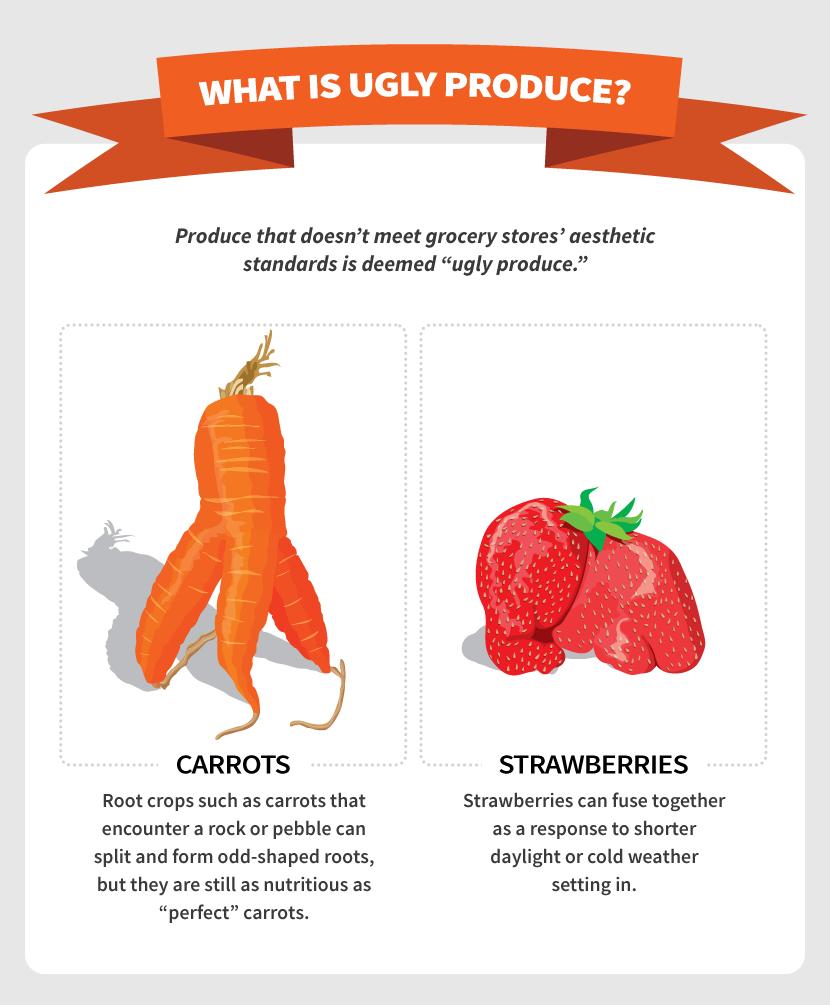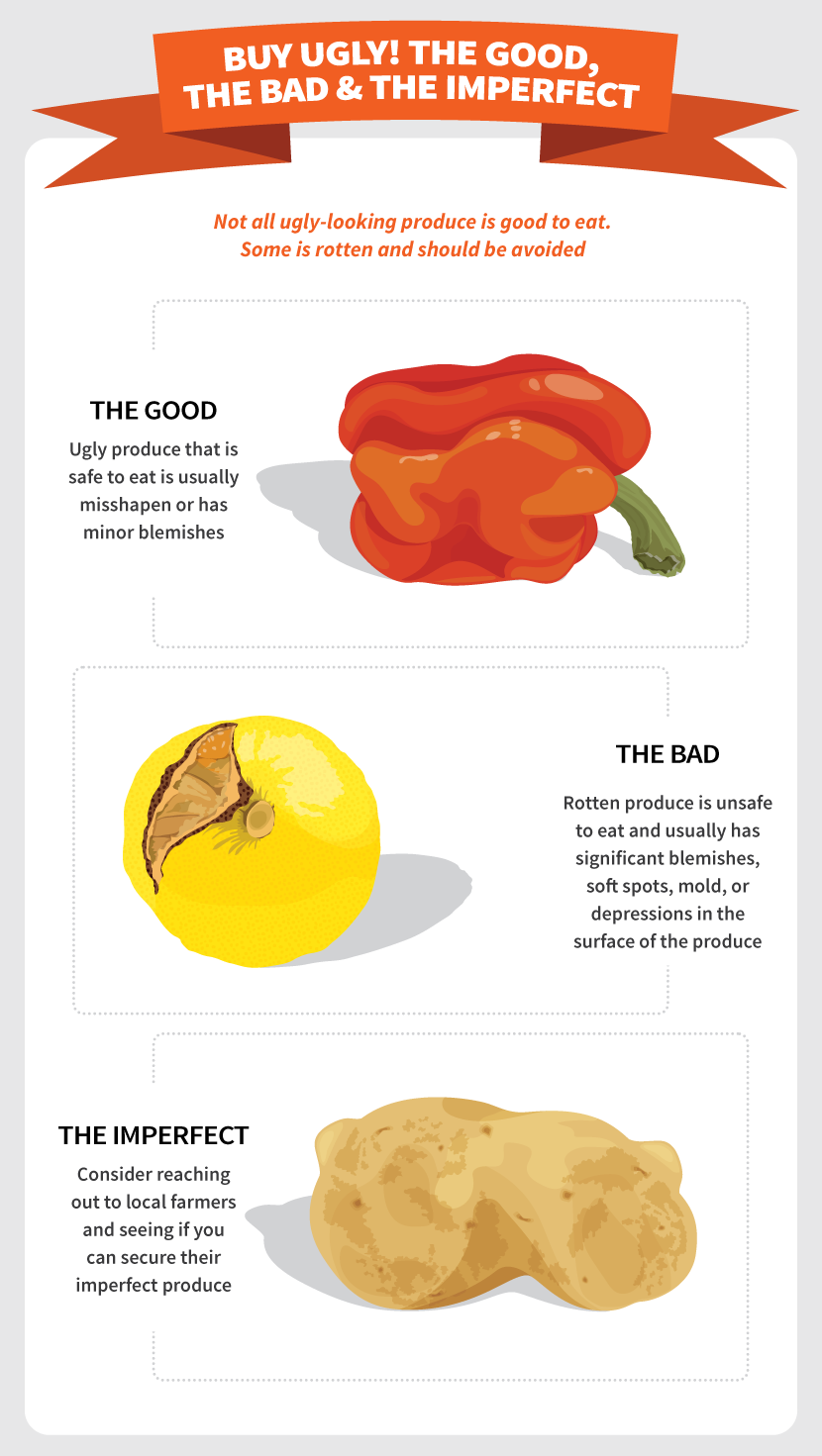'Ugly Produce’:
The Solution to Food Waste?
When we walk into the supermarket, we’re greeted by piles and piles of perfect produce.
Apples stacked to the ceiling, all glistening, waxy, and perfectly shaped.
Large, plump, bright-red strawberries sitting in green plastic baskets, waiting for a customer to take them home.
Spherical white onions, unblemished, wait to be turned into a delicious stir-fry.
It’s a beautiful sight, isn’t it?
It might not be. In fact, it may be one of the greatest crimes against the environment that no one knows
about. The pressure from grocery stores and supermarkets to only accept “perfect” produce leads to a huge amount
of produce going to waste, simply because it’s not aesthetically pleasing.
The movement to encourage the sale and consumption of so-called “ugly” produce is growing.
In this article, we’ll learn what it is, some of the shocking statistics behind food waste,
and how to tell the difference between produce that is simply ugly and produce that is truly bad to eat.

If we were grocery store owners, we might not want to sell ugly produce either.
But before we get into the statistics, let’s understand how ugly produce comes to be.
After all, we’re dealing with nature, and nature is often imperfect. If you think that all apples look like the ones you can buy in a supermarket, you’d be sorely mistaken. The same logic applies to root crops such as carrots,
potatoes, and onions, as well as fruits such as strawberries.
Soil Issues
In root crops, especially carrots, the quality of the soil has a large impact
on the eventual shape and appearance of the crop. Carrots like loose, sandy soil that they can work through
easily to create a long and straight root. If the taproot encounters hard soil, rocks, or even pebbles,
the root can split and twist into a deformed shape. The resulting carrot is just as nutritious and
delicious as a straight carrot, but won’t be sold at most grocery stores due to its appearance.
Growing Conditions
In some cases, farmers deal with inclement weather that affects the appearance
(but not the nutrition and safety) of a piece of produce.
For example, certain strawberry varieties respond to colder days with less sunlight by fusing their fruits
together, creating oddly shaped “super-strawberries” that don’t come close to resembling the
classic strawberry shape we know and love.
In most cases these strawberries are just as good as “normal” berries,
but again are barred from sale at grocery stores due to their ugliness.

It might seem reasonable not to sell ugly produce: if a customer finds it less appealing,
why should grocery stores and supermarkets offer the produce for sale? It’s a business decision, right?
Yes and no. Up to 40 percent of the produce grown in the United States goes to waste due to imperfections.
Not all of these imperfections are classified as ugly, however – some produce can’t be sold because
it’s considered rotten or diseased (more on that later).
It’s reported that one-third of the produce grown globally is wasted due to imperfections.
Think of all of the inputs required to grow that wasted produce – soil, water, fertilizers,
and human labor – and how those inputs could be put to better use if we had a better way to deal with
imperfect produce.
With 50 million Americans suffering from hunger at some point during every year,
there is a clear need for more and better food access. Why not tap into the massive quantity of food that
isn’t sold because it doesn’t look pretty? When suffering from hunger,
appearance is far from the most important quality to care about.
Around the world, companies are popping up and taking a crack at solving
the food waste problem that ugly produce creates. They’re partnering with large and small farmers alike,
picking up their imperfect produce and selling it for 30 to 50 percent below prices for normal produce.
They’re even offering home delivery, which was usually reserved for those with higher incomes.
Because the produce is so cheap, it’s becoming more reasonable to get it delivered to the home,
making food access even easier for low-income families who suffer from hunger during the year.

While the movement to cherish and use ugly produce is growing, that doesn’t mean it’s without its dangers.
If you’re looking to consume more ugly produce in your diet,
you need to make sure you’re choosing produce that is simply deformed or
blemished and not produce that is truly rotten or diseased.
As a general rule, produce that is “ugly” but safe and nutritious to eat:
- Has slight blemishes on the surface, but no significant bruising or soft spots
- Is misshapen, but structurally intact
- Is smaller than average
- Is much larger than average
- Has inconsistent coloration or texture
Produce that is rotten or diseased is an entirely different story.
Don’t try to save money by purchasing this type of produce –
it’s unsafe. Here are a few signs of rotten or diseased produce:
- Has significant blemishes and soft spots that break the surface of the produce
- Is significantly discolored, with the discolorations having different textures (a sign of mold or fungus)
- Has broken skin and open cuts
- Is soft and easy to depress – a sign of recesses in the produce and a good indication that the rotting process has begun
Overall, ugly produce is a huge opportunity to save money on your produce budget while still getting
nutritious and delicious produce – as long as you buy safe. On a global scale, the embrace of ugly produce
by grocery stores, farmers markets, CSAs, and consumers will go a long way toward cutting the
massive food waste numbers down to more reasonable levels.
If you live in an area with access to local farmers,
consider reaching out to them and seeing if you can secure their imperfect produce for you and your family instead of buying
from grocery stores and farmers markets. Going direct will save you a huge amount of money as well as do your part for the environment – a true win-win!
Embed the article on your site

